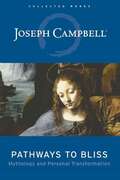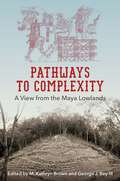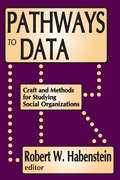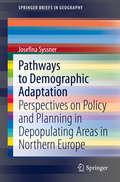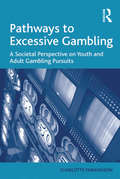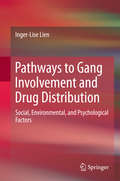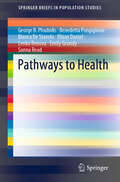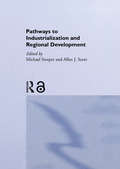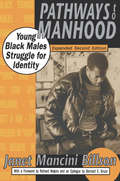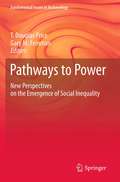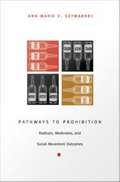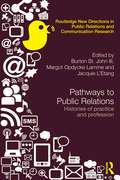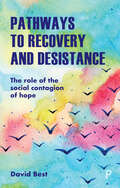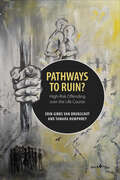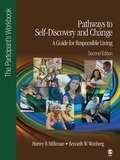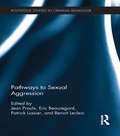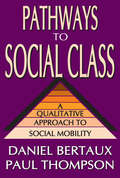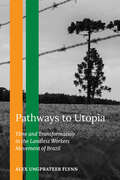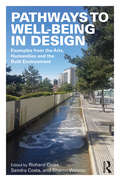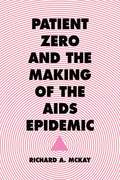- Table View
- List View
Pathways to Bliss: Mythology and Personal Transformation (The Collected Works of Joseph Campbell.)
by Joseph CampbellJoseph Campbell famously defined myth as “other people's religion.” But he also said that one of the basic functions of myth is to help each individual through the journey of life, providing a sort of travel guide or map to reach fulfillment — or, as he called it, bliss. For Campbell, many of the world's most powerful myths support the individual's heroic path toward bliss. <p><p> In Pathways to Bliss, Campbell examines this personal, psychological side of myth. Like his classic best-selling books Myths to Live By and The Power of Myth, Pathways to Bliss draws from Campbell's popular lectures and dialogues, which highlight his remarkable storytelling and ability to apply the larger themes of world mythology to personal growth and the quest for transformation. Here he anchors mythology's symbolic wisdom to the individual, applying the most poetic mythical metaphors to the challenges of our daily lives. <p><p> Campbell dwells on life's important questions. Combining cross-cultural stories with the teachings of modern psychology, he examines the ways in which our myths shape and enrich our lives and shows how myth can help each of us truly identify and follow our bliss.
Pathways to Community Engagement in Education: Collaboration in Diverse, Urban Neighbourhoods
by Catherine M. HandsThis book takes a comprehensive look at community engagement strategies in education to demonstrate the diverse nature of school-community relations and their value to promote their effective development. The author brings twenty years of experience in various educational settings in Ontario and California to examining community involvement policies and their interpretation, as well as school-community collaboration in practice. Chapters include recent research on school-community collaboration from the perspective of teachers, school district leaders, administrators, and support staff within two school districts in a low-income and culturally diverse urban community. The book also includes perspectives from community members involved in organizations across the city with a mandate to work with youth. In a time where students’ academic, social, and emotional support needs are on the rise, this book offers a valuable resource for strengthening school-community relations and demonstrating the power of collaboration.
Pathways to Complexity: A View from the Maya Lowlands (Maya Studies)
by M. Kathryn Brown And George J. Bey IIIPathways to Complexity synthesizes a wealth of new archaeological data to illuminate the origins of Maya civilization and the rise of Classic Maya culture. In this volume, prominent Maya scholars argue that the development of social, religious, and economic complexity began during the Middle Preclassic period (1000–300 B.C.), hundreds of years earlier than previously thought. Contributors reveal that villages were present in parts of the lowlands by 1000 B.C., challenging the prevailing models estimating when civilization took root in the area. Combining recent discoveries from the northern lowlands—an area often neglected in other volumes—and the southern lowlands, the collection then traces the emergence of sociopolitical inequality and complexity in all parts of the Yucatan peninsula over the course of the Middle Preclassic period. They show that communities evolved in different ways due to influences such as geographical location, ceramic exchange, shell ornament production, agricultural strategy, religious ritual, ideology, and social rankings. These varied pathways to complexity developed over half a millennium and culminated in the institution of kingship by the Late Preclassic period. Presenting exciting work on a dynamic and poorly understood time period, Pathways to Complexity demonstrates the importance of a broad, comparative approach to understanding Preclassic Maya civilization and will serve as a foundation for future research and interpretation. Contributors: M. Kathryn Brown | Dr. George Bey III | Tara Bond-Freeman | Fernando Robles Castellanos | Tomas Gallareta Negron | E. Wyllys Andrews V | Anthony Andrews | David S. Anderson | Lauren Sullivan | Jaime J. Awe | James F. Garber | Mary Jane Acuña | William Saturno | Bobbi Hohmann | Terry Powis | Paul Healy | Richard Hansen | Donald W. Forsyth | David Freidel | Barbara Arroyo | Richard E. W. Adams A volume in the series Maya Studies, edited by Diane Z. Chase and Arlen F. Chase
Pathways to Data: Craft and Methods for Studying Social Organizations
by Robert W. Habenstein"It is much better," observed C. Wright Mills in an essay on intellectual craftsmanship, "to have one account by a working student of how he is going about his work than a dozen 'codifications of procedure' by specialists who often as not have never done much work of consequence." This observation underscores the premise of this book: that there is a need for students to communicate the procedures and strategies of field research they have found consequential in their own studies to the less instructed or less experienced. The contributors to this book are well known researchers and share their field-developed techniques of research craftsmanship. The pathways to data they describe wind in a common direction, toward a concern with research happenings in situations: in agencies, associations, institutions, campaigns, demonstrations, and goal-directed social movements.The selections included in "Pathways to Data" are neither biographies of research projects nor subjective evaluations of personal experiences. Rather, the writers emphasize techniques, operations, and know-how. "Pathways to Data's" chapters are collateral cousins to the collection of research biographies found in "Sociologists at Work", another classic in the field. But the lineage, or progression of thought, traces back to the Webbs' Methods of Social Study, and is most closely related to the Glaser and Strauss volume, "The Discovery of Grounded Theory".The contributors to this book reflect a common concern with organization in the "down home" sense of social bonds opening and closing, of self-involvement, and most importantly social structure. Process is stressed above system, becoming over being. Seen programatically, field methods deliver data to concepts, and techniques are grounded in the heuristic value such data display. Theory is grounded in concepts validated by the effectiveness with which they give meaning to the data. The production of social knowledge is symmetrical, reciprocal, but analytically divisible. The student of society will consequently find an assortment of knowledges that makes large portions of our society more understandable.
Pathways to Demographic Adaptation: Perspectives on Policy and Planning in Depopulating Areas in Northern Europe (SpringerBriefs in Geography)
by Josefina SyssnerThis book builds on case studies in depopulating and shrinking areas in Northern Europe. While most contemporary literature on shrinkage focuses on these issues from a planning standpoint, this book uniquely applies a policy perspective when approaching the material. The book assesses the potential of demographic adaptation policies to manage depopulation, that is, policy programs aiming at managing depopulation through adaptation, rather than through growth policies intended to foster population growth. In 6 chapters, the book acts as an up-to-date resource on demographic adaptation for master and Ph.D. students, researchers, and practitioners working in local and regional development, governance, and planning. Chapter 1 gives an overview of recent demographic trends in Northern Europe and introduces the theoretical differences between growth policy and adaptation policy. Chapter 2 accounts for the policy concept and introduces a framework for how local adaptation policies could be systematically analysed. Chapter 3 suggests that the Nordic welfare states exhibit two characteristics that prove to be relevant when discussing the consequences and policy implications of demographic decline, i.e. an extremely sparse population structure and an ambitious welfare assignment that in many respects has been devolved to the local level of government. Chapter 4 suggests that whether shrinkage constitutes a problem or not depends upon the interpretations of those in power, but also upon political, economic and geographic conditions Chapter 5 seeks to understand why local level policymakers avoid developing strategies for how to handle long-term population decline. Chapter 6 summarizes the points of the previous chapters, and concludes that local governments in shrinking areas ought to develop local adaptation policies. These policies, however, also need to be subjected to critical analysis, and the chapter introduces a model for how local adaptation policy priorities could be assessed in a more structured manner.
Pathways to Excessive Gambling: A Societal Perspective on Youth and Adult Gambling Pursuits
by Charlotte FabianssonPathways to Excessive Gambling draws upon extensive empirical research amongst young people and problem gamblers in Australia, comparing it with situations in other territories, to shed light on social, recreational gambling and the ways in which this can lead to excessive gambling. It highlights the relationship between the local community, sports clubs, governments, social recreation, economy and regulation of gambling venues, identifying the social indicators that typify situations which commonly lead to excessive gambling. By developing a 'society-based' perspective, this volume recognizes problem gambling as an issue for the whole society rather than just the individual, focusing on the availability of gambling and identifying its capacity, as a construct, to encourage or restrict the behaviour of the individual. As such, this book will be of significance to social scientists with interests in gambling, young people, social problems, and the sociology of leisure and culture.
Pathways to Gang Involvement and Drug Distribution
by Inger-Lise LienThis book uses a multi-methods study of incarcerated youths to examine the pathways to gang involvement, the drug distribution system and hierarchy within gangs, levels of traumatic stress and depression among gang-involved youths, and other mechanisms of control and retention within the system of gangs. Based on a study of young inmates in Norway, with international backgrounds including Africa, Pakistan, Middle East and Western Europe, the findings explained in this book are broadly applicable. It aims to create a picture of the entire system of gang membership, while revealing a research framework that could be applied to other studies. Gang members were found in high levels to be suffering from depression and traumatic stress, and were often heavily indebted (financially and otherwise) to persons in the outside world. Owing money, violence and other threats, all make it difficult to leave the system, despite the pains they suffer within it. In order understand young peoples' life within the system, and its hold on them, and in order to reduce its continuation and growth, this important analysis helps researchers and policy makers, particularly those interested in juvenile justice, youth gangs, and drug trafficking understand its logic and identify its weak points and possible ways out.
Pathways to Health (SpringerBriefs in Population Studies)
by George B. Ploubidis Benedetta Pongiglione Bianca De Stavola Rhian Daniel Lenka Benova Emily Grundy Sanna ReadThis book presents a rigorous enquiry into life course processes that are thought to influence health, integrating the latest methodologies for the study of pathways that link socio-demographic circumstances to health with an emphasis on the mediating factors that lie on these pathways. Following an introductory chapter on the application of formal mediation methods within the life course framework, the book offers insights on the pathways that link early life socio-economic circumstances to physical activity in later life, the role of physical activity as a moderator and/or mediator of the association between fertility history and later life health and the evolution of self-rated health over the life course in two generations born 12 years apart in 20th century Britain. Pathways to Health presents a dynamic view on how to investigate specific hypotheses within the life course framework and enhances the ability of the social science community to investigate specific mechanisms related to public health interventions.
Pathways to Industrialization and Regional Development
by Michael Storper Allen J. ScottThe world has seen a shift in socio-economic relations, in the patterns and processes of industrialization and regional development. The social regulation of the economic order, flexible production organization and industrial district formation have brought periods, places and pathways to the heart of economic debate. Pathways to Industrialization and Regional Development provides a platform from which to address a new economic order. All the major schools of thought are represented. Focussing upon the interactions between economic logic and political institutions at both the local and global levels, the authors set the agenda for the 1990s.
Pathways to Manhood: Young Black Males Struggle for Identity
by Janet Mancini BillsonIn Pathways to Manhood, published in cloth as Strategic Styles: Coping in the Inner City, Janet Maricini Billson studies five young boys who grew up in Roxbury, Massachusetts, during the Intense racial and political turmoil of the late 1960s and early 1970s. Using data from Harvard's Pathways to Identity project, she analyzes how healthy ego striving develops in the social and physical decay of an Inner-city environment.The author draws a rich and absorbing portrait of each boy and of his life. Although they grew up in the same social context, the boys became very different individuals. In a new preface to this expanded edition, Billson maintains that it is still vitally Important to understand the coping styles that young black males develop in the face of adversity.Bernard E. Bruce traces what happened to the five boys, who are now men In their forties, in his poignant epilogue, "From Boys to Men." A new chapter on Intervention strategies shows how parents, teachers, and others who work with inner-city youth can most effectively support positive coping styles. Graphic representations help visualize both the styles and the intervention strategies.This classic book is a valued resource for parents; for those who work in the helping professions, education, and the criminal justice system; and for students of sociological theory, social psychology, human development, and race relations.
Pathways to Nationalism: Social Transformation and Nationalist Consciousness in Colonial Tamil Nadu, 1858–1918
by S. GaneshramThis book examines the socio-economic factors in the rise and development of nationalism in the Tamil-speaking region of the Madras Presidency in India between 1858 and 1918. It analyses the dynamic interaction between socio-economic conditions and nationalism in Tamil Nadu by applying both historical methods of documentary analysis and a sociological perspective. The volume looks at the advent of Western education and the role of Christian missionaries, the growth of the local press, socio-religious reform movements, decline of indigenous industries and the land revenue policies of the colonial government to arrive at a comprehensive portrait of the rise of nationalism in the Madras Presidency. The volume is invaluable for scholars of colonial history and the Indian freedom movement in southern India.
Pathways to Power
by Gary M. Feinman T. Douglas PriceThere are few questions more central to understanding the prehistory of our species than those regarding the institutionalization of social inequality. Social inequality is manifested in unequal access to goods, information, decision-making, and power. This structure is essential to higher orders of social organization and basic to the operation of more complex societies. An understanding of the transformation from relatively egalitarian societies to a hierarchical organization and socioeconomic stratification is fundamental to our knowledge about the human condition. In a follow-up to their 1995 book Foundations of Social Inequality, the Editors of this volume have compiled a new and comprehensive group of studies concerning these central questions. When and where does hierarchy appear in human society, and how does it operate? With numerous case studies from the Old and New World, spanning foraging societies to agricultural groups, and complex states, Pathways to Power provides key historical insights into current social and cultural questions.
Pathways to Prohibition: Radicals, Moderates, and Social Movement Outcomes
by Ann-Marie E. SzymanskiStrategies for gradually effecting social change are often dismissed as too accommodating of the status quo. Ann-Marie E. Szymanski challenges this assumption, arguing that moderation is sometimes the most effective way to achieve change. Pathways to Prohibition examines the strategic choices of social movements by focusing on the fates of two temperance campaigns. The prohibitionists of the 1880s gained limited success, while their Progressive Era counterparts achieved a remarkable--albeit temporary--accomplishment in American politics: amending the United States Constitution. Szymanski accounts for these divergent outcomes by asserting that choice of strategy (how a social movement defines and pursues its goals) is a significant element in the success or failure of social movements, underappreciated until now. Her emphasis on strategy represents a sharp departure from approaches that prioritize political opportunity as the most consequential factor in campaigns for social change. Combining historical research with the insights of social movement theory, Pathways to Prohibition shows how a locally based, moderate strategy allowed the early-twentieth-century prohibition crusade both to develop a potent grassroots component and to transcend the limited scope of local politics. Szymanski describes how the prohibition movement's strategic shift toward moderate goals after 1900 reflected the devolution of state legislatures' liquor licensing power to localities, the judiciary's growing acceptance of these local licensing regimes, and a collective belief that local electorates, rather than state legislatures, were best situated to resolve controversial issues like the liquor question. "Local gradualism" is well suited to the porous, federal structure of the American state, Szymanski contends, and it has been effectively used by a number of social movements, including the civil rights movement and the Christian right.
Pathways to Public Relations: Histories of Practice and Profession (Routledge New Directions in Public Relations & Communication Research)
by Burton St. John Margot Opdycke Lamme Jacquie L’EtangOver the centuries, scholars have studied how individuals, institutions and groups have used various rhetorical stances to persuade others to pay attention to, believe in, and adopt a course of action. The emergence of public relations as an identifiable and discrete occupation in the early 20th century led scholars to describe this new iteration of persuasion as a unique, more systematized, and technical form of wielding influence, resulting in an overemphasis on practice, frequently couched within an American historical context. This volume responds to such approaches by expanding the framework for understanding public relations history, investigating broad, conceptual questions concerning the ways in which public relations rose as a practice and a field within different cultures and countries at different times in history. With its unique cultural and contextual emphasis, Pathways to Public Relations shifts the paradigm of public relations history away from traditional methodologies and assumptions, and provides a new and unique entry point into this complicated arena.
Pathways to Recovery and Desistance: The Role of the Social Contagion of Hope
by David BestAvailable Open Access under CC-BY-NC licence. This is the first book that uses the latest research evidence to build guidance on community-based rehabilitation with the aim of challenging stigma and marginalisation. The case studies discussed, and a strengths-based approach, emphasize the importance of long-term recovery and the role that communities and peers play in the process. Best examines effective methods for community growth, offers sustainable ways of promoting social inclusion and puts forward a new drug strategy and a new reform policy for prisons.
Pathways to Ruin: High-Risk Offending over the Life Course
by Erin Gibbs Van Brunschot Tamara HumphreyIndividuals who have committed a number of crimes over their lifetimes have had complex, multi-faceted life experiences often characterized by extreme disadvantage and victimization. Those who are formally designated as "high-risk" by the Canadian criminal justice system often have a record of violent or sexual crimes. As a result, they are usually subject to additional monitoring in the community after completing a prison sentence. Pathways to Ruin disentangles the numerous elements and pathways that lead to high rates of reoffending by focusing on developmental periods of childhood, adolescence, and adulthood. The book uses a case-study approach to consider individuals’ entire crime pathway by examining the circumstances and factors that contribute to assumptions or official designations of "high-risk" behaviour. Erin Gibbs Van Brunschot and Tamara Humphrey overhaul society’s popular crime narratives and instead draw on sociological and criminological perspectives to identify historical, social, and personal contexts that appear to increase the likelihood of reoffending. They also consider how negative life experiences may be addressed to circumvent trajectories of serious offending. Reducing the social distance that the "law-abiding" public may feel towards marginalized groups, Pathways to Ruin details how legal systems could better serve these individuals, and acknowledges the many missed opportunities for compassion.
Pathways to Self-Discovery and Change: A Guide for Responsible Living: The Participant's Workbook (2nd Edition)
by Dr Kenneth W. Wanberg Harvey B. MilkmanPathways to Self-Discovery and Change: A Guide for Responsible Living - The Participant’s Workbook, Second Edition provides a written and richly illustrated format through which clients can better understand and reflect on each of 32 (approximately 90 to 120 minutes in length) youth-focused CBT treatment sessions. Pathways to Self-Discovery and Change supplies clients with a visual and written record of all treatment objectives, content information, modeling and role-plays, discussion points, interactive exercises, and reflective assignments and a place to record their ideas, insights, short- and long-term goals, and progress during the entire treatment episode. The Participant’s Workbook is geared to a broad range of reading and conceptual abilities. Using comic strip illustrations and gripping stories (presented through the narrative voice of teenagers who experience a variety of problems with substance abuse, criminal conduct, and mental health issues), clients are engaged in active discussion about the situations, thoughts, emotions, and behaviors that have become embroidered in their patterns of substance abuse and criminal conduct.
Pathways to Sexual Aggression: Pathways To Sexual Aggression (Routledge Studies in Criminal Behaviour)
by Patrick Lussier Benoit Leclerc Jean Proulx Eric BeauregardMost people who read an article in the newspaper about the brutal rape of a woman by a stranger, or the long-standing sexual abuse of a young boy by his step-father have a strong visceral reaction which is a mix of anger, fear, and incomprehension. Apart from these aversive reactions, several questions also come to people’s minds: Was this offender crazy or sexually obsessed? What is the purpose of such outrageous acts? To answer these questions, the authors of this book review theoretical and empirical models of the processes that lead men to sexually assault children or women, whilst also presenting new results and models on this topic. In particular, this book focuses on empirical analyses of the pathways of six types of sexual aggressors, three of which (marital rapists, hebephilic sexual aggressors, and polymorphic sexual aggressors) have never been investigated before. Drawing on a large dataset on the offending processes of sexual aggressors, this book analyzes the influence of personality factors and lifestyle factors on offending pathways and brings together key researchers in the field of sexual aggression. This book will be of interest to psychologists, psychiatrists, criminologists, and social workers involved in the study, assessment and treatment of sexual aggressors. In addition, this information will be crucial for practitioners involved in the follow-up of these offenders in the community, and will interest researchers and graduate students in the field of sexual aggression.
Pathways to Social Class: A Qualitative Approach to Social Mobility
by Paul Thompson Daniel BertauxCalling for a broader, new approach to social mobility research, Pathways to Social Class: A Qualitative Approach to Social Mobility moves beyond pure statistics to use qualitative techniques-such as life stories and family case studies-to examine more closely the dynamics of mobility and address more fundamental sociological questions.
Pathways to Utopia: Time and Transformation in the Landless Workers Movement of Brazil
by Alex Ungprateeb FlynnPathways to Utopia explores how Brazil's Landless Workers Movement (Movimento dos Trabalhadores Rurais Sem Terra, or MST), against all odds, has endured for forty years as one of the world's largest social movements—while transforming the way we understand the temporality of activism. Taking his cue from MST members and their generational struggle for land and justice, anthropologist Alex Ungprateeb Flynn reveals how the movement's longevity stems not only from its strong organization and collective vision but also from the productive tensions between established utopian ideals and emerging counter-utopian practices. Perceived by some as a shortcoming, this friction has proven to be a generative force, sparking creative gestures that reimagine social relations and ensuring the MST's adaptability in an ever-changing political landscape.Flynn chronicles the everyday lives of families navigating an extraordinary political reality over a fifteen-year period. At the heart of Pathways to Utopia is the realization that activism is not a momentary act but an ongoing, relational practice—one where even the smallest community actions reverberate, reshaping the very structures through which people seek to change the world.Evocatively written and balancing careful ethnography with key theoretical interventions, the book illuminates the dreams and sacrifices that characterize a life lived as struggle. Unfolding across multiple points of time, Pathways to Utopia tells a story of hope and resilience—one that promises a lasting influence on our twenty-first-century political imagination.
Pathways to Well-Being in Design: Examples from the Arts, Humanities and the Built Environment
by Richard Coles Sandra Costa Sharon WatsonHow can we achieve and promote well-being? Drawing on examples from the arts, humanities and design, this book brings together work from a wide range of areas to reveal the unique ways in which different disciplines approach the universal goal of supporting well-being. Pathways to Well-Being in Design recognises that the distinction between academics and practitioners often becomes blurred, where, when working together, a fusion of thoughts and ideas takes place and provides a powerful platform for dialogue. Providing new insights into the approaches and issues associated with promoting well-being, the book's multi-disciplinary coverage invites readers to consider these ideas within the framework of their own work. The book's 12 chapters are authored by academics who are involved in practice or are working with practitioners and features real world case studies which cover a range of situations, circumstances, environments, and social groups. Pathways to Well-Being in Design responds to those wishing to enquire further about well-being, taking the reader through different circumstances to consider approaches, discussing practice and theory, real world and virtual world considerations. This book is essential reading for anyone seeking to understand well-being, including students and professionals in architecture, landscape architecture, urban planning, design and health sciences.
Pathways: A Guided Workbook for Youth Beginning Treatment (Fourth Edition)
by Timothy J. KahnThe Pathways workbook has been a cornerstone in the treatment of sexually aggressive youth since the first edition was issued twenty years ago. As the field has evolved and advanced, so has Pathways. This new Fourth Edition reflects current research and clinical experience with adolescents by focusing on strength-based methods to help clients develop healthy and productive lifestyles consistent with the Good Lives Model of rehabilitation. Pathways continues to use a restorative justice theme emphasizing concern for restitution, development of victim empathy and personal responsibility. Focus is shifted from the offense cycle into understanding the antecedents to a client?s sexual acting out. The Fourth Edition incorporates quizzes into the end of each chapter. Experience has shown that the quizzes are a rewarding and helpful way to ensure that clients are reading and comprehending the material in the chapters. The tests also provide the client with a tangible sense of accomplishment. Pathways is written for both adolescent boys and girls, and is appropriate for both adjudicated and non-adjudicated clients with a wide variety of sexual behavior problems.
Patient Records and Addiction Treatment
by Gerry Coughlin Sherry S. Kimbrough Landon L. KimbroughA text which outlines the procedures and rationale of case management, current information on research, principles of sound clinical practice, clinical documentation and practical experience.
Patient Safety and Serious Incident Responses: The Essentials
by Alison Elliott Karen M. WrightThis step-by-step guide takes the reader through the complex process of investigating serious incidents in health, social care, and criminal justice environments, acknowledging differences of culture and context that shape an investigation. Taking a multi-disciplinary approach, Part 1 begins by exploring the key principles of investigation, including ethical and legal perspectives, the involvement of families and carers, and being aware of unconscious bias, among other issues. Part 2 outlines in detail the conduct of investigations, from planning to processing the findings, before moving on to Part 3, carrying them out in diverse settings. Further chapters then look at investigating within diverse environments before moving on to to Part 4 which deals with reviewing and analysing the evidence collected and writing up the investigation. This final part also examines the pivotal issue of learning from the investigation and disseminating the report. The inclusion of case studies, models of good practice, and vignettes enables the reader to view each stage of the process in context and drive the transformation of practice. This practical resource is designed to support health and social care professionals who undertake investigations as part of their role, including nurses, allied health practitioners, social workers, doctors, and psychologists, as well as military personnel and law enforcers. It is an essential companion.
Patient Zero and the Making of the AIDS Epidemic
by Richard A. McKayNow an award-winning documentary feature film The search for a “patient zero”—popularly understood to be the first person infected in an epidemic—has been key to media coverage of major infectious disease outbreaks for more than three decades. Yet the term itself did not exist before the emergence of the HIV/AIDS epidemic in the 1980s. How did this idea so swiftly come to exert such a strong grip on the scientific, media, and popular consciousness? In Patient Zero, Richard A. McKay interprets a wealth of archival sources and interviews to demonstrate how this seemingly new concept drew upon centuries-old ideas—and fears—about contagion and social disorder. McKay presents a carefully documented and sensitively written account of the life of Gaétan Dugas, a gay man whose skin cancer diagnosis in 1980 took on very different meanings as the HIV/AIDS epidemic developed—and who received widespread posthumous infamy when he was incorrectly identified as patient zero of the North American outbreak. McKay shows how investigators from the US Centers for Disease Control inadvertently created the term amid their early research into the emerging health crisis; how an ambitious journalist dramatically amplified the idea in his determination to reframe national debates about AIDS; and how many individuals grappled with the notion of patient zero—adopting, challenging and redirecting its powerful meanings—as they tried to make sense of and respond to the first fifteen years of an unfolding epidemic. With important insights for our interconnected age, Patient Zero untangles the complex process by which individuals and groups create meaning and allocate blame when faced with new disease threats. What McKay gives us here is myth-smashing revisionist history at its best.
